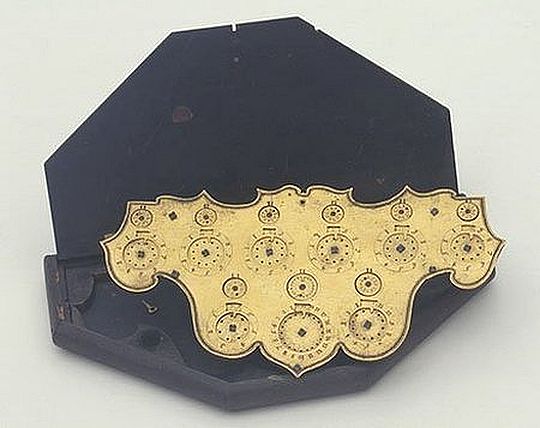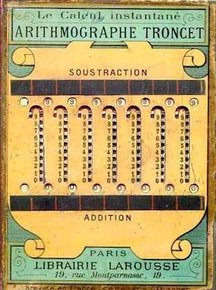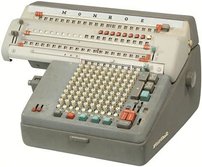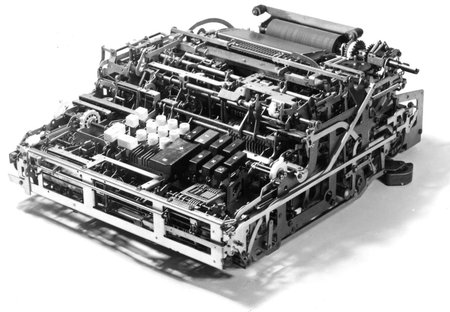The mechanical calulator
Mechanical calculator, pascaline, adding machine, arithmometer: protagonists of the economy for 350 years.
The first mechanical calculator was probably imagined by Leonardo da Vinci, Pascal invented the cheap and widespread pascaline, still on the market only 35 years ago.
These models were followed by the arithmometer, the adding machine, the Comptometer up to the perfect mechanical calculator: the Olivetti Divisumma. Let's briefly see the history of the mechanical calculator.
"For the world and our country: 90 degrees north! The Nautilus had accomplished the impossible"
With these words, at 23:15 GMT on August 3, 1958.
Captain Anderson announced to the crew that the first nuclear submarine had reached the North Pole navigating beneath the arctic ice cup.
On board was still using a mechanical calculator, the latest in a series of calculating machines designed in 1600.
Let's look at its history.
In 1966 Were found in Madrid a Leonardo's manuscripts considered lost. A drawing seems to represent a mechanical calculator.

Leonardo's calculator, Codex Madrid I ca. 1500 (B. N. Madrid)
A reproduction of Leonardo's computer was built by IBM in the 60s.
The original could not work due to excessive friction and the first mechanical calculator can be attributed to the German scientist Schickard in 1623.
His calculator was destroyed by a fire in 1640 and was Pascal who finally succeeded in make a working adding machine.
In 1673 Leibniz designed a sophisticated computer.
The architect Perrault had already designed a couple of years before a pocket calculator.
The era of mechanical calculation was beginning.
These prototypes were too complex for the technology of the time and could only be built by hand in pieces almost unique, but the patent of Pascal gave life to economic pascaline.
That of Perrault to a line of small arithmographs.
The project of Leibniz, later improved by Odhner, was adopted by the major brands for the most prestigious models.
The keyboards appeared to the last years of 1800 and the story ends in 1956 with the innovative Olivetti Divisumma, a perfect epitome of all the features always wanted.
In the early 70s the appearance of electronic computers wiped out these machines on the market.


This big calculator, ca 1650 and the little Curta, 1952
The mechanical calculators, except the Olivetti Divisumma, are derived from inventions of 1600 and were built until the mid 70s.
The history of computing is formed by hundreds of inventors that helped to create the basis for future developments: it is impossible to mention them all.
Pascal and the pascaline
In 1642, at the age of 19, Blaise Pascal built the first calculator.
This machine, designed for the French monetary system and called by everyone pascaline, performed quickly the sum, but for subtraction was necessary to use the method of complement to 10 and multiply or divide was not easy.
With the Revolution France was converted to the decimal system, but traditions die hard.
Flowers and eggs still buy by the dozen.
In the pascaline shown below the display is split in Thousands, Hundreds, Tens, Nombres Simples (unit), Sols (20 Sols = 1 Nombre Simple) and Deniers (12 Deniers = 1 Sol).

Pascaline, 1650 (replica by R. Guatelli - Museo Leonardo - Milan)
The invention of Pascal was not immediately successful.
At the time was impossible to solve the problem of friction and many tried to improve this machine, often creating beautiful pieces by fancy names.
The pascaline was little used until the advances in technology allowed the development of reliable models.
The most beautiful examples, inspired by the design of Pascal, were executed by Tito Livio Burattini and Samuel Morland, both given as gifts to Cosimo III de'Medici, but the pascaline remained in the shadows until the strong economic development of the United States pushed the inventors to redraw it rationally.

The Burattini's Ciclografo, 1660 (@ Museo Galileo - Florence)
In 1901 appeared on the U.S. market "The Calcumeter", the first pascaline really cheap and functional.
This mechanical calculator met with great success and was widely, but was difficult to perform subtraction, multiplication and division.

![]()
The Calcumeter, 1901, one of the first working Pascalines
In the 1930 it was realized finally that, by turning the wheel in the opposite direction and using a second reversed numerical scale, it was possible to perform the subtraction as negative addition.
The pascaline changed little over the years and the production ended around 1975.
It had been built in more than 5 million units.

Lightning, a best seller
The single column pascaline
At the end of the 1800 was very successful a model of pascaline with the display of only two or three digits, able to add just the numbers of each column performing the carry with memory.
There were many models. The Webb Adder was controlled by sliding it in the thumb, the Stephenson was smaller and thinner than a modern credit card.
The Adix had a rudimentary keyboard.
All were very successful and some were marketed for over 50 years.

![]()
Webb Adder, ca. 1891: a very simple adding machine

The small Adix had a keyboard, ca. 1901
Leibniz and followers
Leibniz in 1673, inspired by the patent of Pascal, designed a sophisticated computer using its innovative "drum" (or stepped drum).
Addition and subtraction are performed as in pascaline.
The multiplication is carried out by repeated additions.
To get the result of 15x4 we must add 15 +15 +15 +15, subtracting we can divide.
The technology involved is complex, it is enough to know that we do not need to perform all the sums because the process is mechanized.
In the pascaline the numbers are immediately added and the drum saves them in a mechanical memory that allows re-use.
Furthermore the drums, one for each column, can sliding in the side allowing to multiply automatically by powers of 10.
Wanting to perform 540x123 does not need to perform 123 additions, but simply set on the cylinders 540, summing it 3 times, move the drums one position to the left, add 2 times, move and add once.
The number of additions or subtractions consecutive is controlled by a lancet.
To perform a multiplication it is sufficient to point the lancet on the number of additions desired and the calculator will perform them autonomously.

Leibniz's calculator in an old print
Imagining a super calculator Leibniz also invented the binary system, presented March 15, 1679 in the manuscript of only three pages "De Progressione Dyadica."
Too modern for the time was not understood and the first machine of this type was built in 1936.
Today it is the mathematical basis of computer, designed for this purpose when the electricity was not yet known.
The Leibniz's calculator was difficult to build but had many emulators as Poleni, Leupold and Braun, who produced works of art even if not very functional.

Braun's calculator, 1736
Thomas de Colmar improved the Leibniz's calculator in 1820. Cumbersome and expensive its Arithmometre, however, was very reliable and was produced until 1915 in 1,500 units.

The Arithmometre, ca 1855.
The Arithmometre had no followers because Odhner was now flooding the market with its new model of calculator, more light and practical to use.
Finally we can not forget the little Curta, designed by Kurt Herzstark during World War II.
230 grams to perform the four operations with a display of 11 digits, a miniature jewel of great success in spite of the prohibitive cost.
The principles of large machines designed 300 years before they were finally realized thanks to modern construction technology.
Willgodt Odhner
Willgodt Odhner, Swedish engineer and entrepreneur, worked in St. Petersburg in the factory of Alfred Nobel's brother.
In 1871, while repairing a Arithmometre, he realized that it was possible to redesign the Leibniz's drum in a more practical way.
It took 19 years before starting production, but his calculator was an instant success.
This machine is based on the "Pin Wheel" modification to the drum of Leibniz, which speeds up the repeated additions necessary to multiply.

Odhner mechanical calculator, ca. 1920 (@ Kees Nagtegaal)
It was copied by many companies, the main were: Brunsviga, Triumphator, Walther, Thales, Muldivo, Felix, Tiger and Busicom.
The latter has been famous as, in 1970, asked the Intel to create a chip for a modern machine designed to replace the old Odhner project.
Federico Faggin, at the time technical director of the Intel, developed the revolutionary 4004 microprocessor and the new Busicom141-PF was the first small electronic calculator.
The tiny signature "FF", hidden deep inside, certified the Italian origin.

The "Pin Wheels" (@ Kees Nagtegaal)
In the 50s, with millions of units built by different companies, the successor of the Leibniz's machine was one of the best-selling calculators.
The production increased up to 10,000 units per day in 1970.
With the appearance of electronic calculators the decline was immediate and in 1972 were no longer marketed.
In two years the world had really changed.

The last mechanical Busicom, 1970 (@ John Wolff)
Perrault and the aritmographs
Let's go back a little back in time.
The architect Claude Perrault, famous for the facade of the Louvre, designed around 1670 a pocket adding machine, the Abaque Rhabdologique, passed unnoticed at the time despite his description had been published in 1699.
At the end of the 1800 this project formed the basis for a whole series of small Slide and Chain Adder, in which the numbers are inserted by sliding some sliders with the help of a stylus.
The differences between the two models are just techniques. Slide Adder using a movable cursor, the Chain Adder a small chain.

Comptator, pocket adding machine, ca. '900

Golden Gem, little "Chain Adder", ca. 1917
The design of Perrault was simplified in 1847 by Kummer, but only in 1889 Troncet Louis managed to successfully commercialize this change.
Thus was born a line of small and very practical aritmographs, copied by many companies under the name of "addiator", and built with no changes until 1988.
A long life, for a simple and ingenious instrument. In those days did not come out something new every 6 months.


In 100 years nothing has changed for the adding machine

Exadecimal aritmograph for computer's programmers
The aritmograph was extremely popular for almost 100 years.
They were no longer marketed in Europe after 1979, but remained in production for the Soviet market until 1988.
Inventories were still on sale in the early 90s.
The Russians, in fact, did not have batteries for the electronic calculators!
Felt and the full keyboard
After several attempts, such as those of Louis Torchi and Tito Gonnella, in 1887 a new category of calculators was born.
The Key Driven, equipped with a large keypad that directly actuates the mechanism and the crank only serves to reset.
The keys are arranged in columns, one for each decimal point, with the numbers 1 to 9. A calculator with 6 columns calculates up to 999,999; with 10 to 9, 999, 999, 999.
The Burroughs Duodecillion arrived at this incredible number: 9, 999, 999, 999, 999, 999, 999, 999, 999, 999, 999, 999, 999, 999!

360 keys for the Burroughs Duodecillion adding machine, 1915
The project, inspired by the pascaline, was patented by the American Dorr Felt.
Funny to remember that the prototype of its Comptometer was built inside a wooden box for spaghetti bought at the grocery store and these machines are remembered as "Macaroni Box".
Felt set up its factory with his friend and financier Robert Tarrant, coming soon in dispute with William Bourroghs, that in 1905 had begun to produce very similar machines.


Model 1900 (@ Mark Richards) and 1960 (@ John Wolff)
In the Key Driven pressing a button gives the sum of the corresponding value in the correct decimal place, to input the zero must simply jump the column, and all figures are released simultaneously with both hands.
An expert Comptometrist is very fast in executing long series of additions and this keyboard was in use for nearly a century, even in the first electronic calculators.
The Comptometer can also perform multiplication and division, but the procedure is quite complicated.

Half-keyboard calculator, ca. 1947 (@ John Wolff)
The extended keyboards were so complex and expensive that were also realized calculators "Half Keyboard" with the numbers on the keyboard only up to 5.
This system saved half machine and half price. 7 had to be typed as 4 + 3. Imagine to perform 6,789.77 + 9,876.96 + 8,690.89. Very easy to make mistakes!
The major suppliers were Felt&Tarrant, Burroughs and Bell Punch, but all models were called by the name Comptometer designed by Felt in 1887.

1961: the first electronic calculator used in offices:
Bell Punch "ANITA" (A New Inspiration To Arithmetic)
The direct multiplication
All the calculators that we have seen are simple adders that can, with repeated addition and subtraction, perform the four operations.
It required a great attention by the operator and many people tried to overcome this limitation.
The French Leon Bollè, the last known as the creator of the "24 hours" of Le Mans, built some machines that multiplied directly.
The Swiss Hans W. Egli who, inspired by the principles of Leibniz, patented in 1893 the first calculator able to multiply effectively.
His "Millionaire" was moderately successful and in 1913 he began to produce a new model called MADAS (Multiplication, Automatic Division, Addition, and Subtraction).
The Millionaire ended his career in 1920, but for its robustness remained in use for over 30 years in many offices.
This kind of Calculators are tiring to operate and were equipped with electric servo motor.

The Millionaire (@ John Wolff)
Trying to improve the performance of MADAS the American J.R. Monroe built from 1914 his own line of calculators.
Composed of more than 4,000 pieces were obviously very expensive and were mainly used in scientific laboratories or where there was need for many multiplications with untrained operators.
At the time the offices chose different models depending on the task to perform, and a full functionality in all operations was reached only in 1956 with the Olivetti Divisumma.
The direct multiplication was also developed by other factories like Friden and the Italian Lagomarsino.


The first and the last Monroe calculators, 1920-70 (@ John Wolff)

This advertising praises the ease of use, but
today few would be able to use this calculator
Capellaro, Olivetti and the Divisumma
Natale Capellaro joined Olivetti in 1916 as an apprentice worker, in 1943 became Director of Projects and from 1960 was Technical Chief.
Two years later he was awarded of an honorary degree in engineering and for his extraordinary achievements deserves a prominent place among the great inventors.
In the early days he was assigned to the assembly of typewriters but later will be the creator of almost all calculators.
His first model was the Elettrosumma of 1945,
which was followed in 1956 by the fantastic Divisumma that poses the Olivetti at the top of the world market.
It was the first calculator capable of performing the four operations without the need for skilled workers, with modern features without deriving from the principles of 1600.
The goal of many inventors had finally realized, unfortunately late, and were short-lived.
The electronics was now reaching maturity and the latest Divisumma were no longer mechanical.

Olivetti Divisumma, ca. 1960 (@ John Wolff)
The series included the Multisumma (addition, subtraction and multiplication), the Divisumma (including division) and Tetractys, equipped with a mechanical memory,
electric motor and double totalizer, which represented the state of the art.
None had the display. The numbers entered and the results could be read only after they are
printed. They found the quickest way to operate according to the requested operation, reducing for example 3 x 3 x
99,999 to 3 x 100,000 - 1, then using a very short time.
Nothing like it had ever been conceived before and Marcello Nizzoli, Ettore Sottsass and Mario Bellini oversaw the
design, creating works of reference for the style of the period.

No display: only print results
They were complex mechanism to build but were marketed up to 10 times the cost of production. Despite the very high price, more than a million and a half were sold.
The Divisumma was therefore essential for the prosperity of Olivetti and was jokingly called "The goose that lays the golden eggs." The high gains slowed the company in the
development of electronic calculators.
The management was convinced, as Henry Ford with his "Model T", that traditional calculators would always be sold without the need
for further investment. A missed opportunity for Olivetti.
The end of an era
In the 60s the mechanical calculators were used in all commercial and financial applications. Data processing centers had the direct multiplication models, in large
offices there were the Odhner type, derived from the project of Leibniz and the Key Driven invented to the 1800.
Small shops had the pascalines, the aritmographes designed by Perrault in 1600 were always present in all the pockets.
The Olivetti, although arrived later on the market, were quickly conquering it. The first electronic
calculators had excessive costs and there was no competition until 1970, when the spread of transistors and LEDs allowed the creation of small and affordable equipment.

Olivetti, sometimes surviving in the Post Offices (@ J. Wolff)
However the transition was slow. Engineers and scientists have replaced immediately their slide rule, but in the offices these machines were changed only when they broke.
There was in fact a generation of workers trained to use them, and for this reason we still write with the same keyboard invented in 1878. Using a more modern one we
would not be faster, but only confused.


In 1973 you could choose between these two models ...

... and this new electronic Divisumma: the era
of the mechanical calculator was ending

On board of the firsts nuclear submarines were
used exclusively the mechanical calculators
Mechanic Calculator Links:
The mechanical calculator on Wikipedia
Prehistoria de la Informatica
Vintage calculators
Everything on the Mechanical Calculator
The Bible of the Mechanical Calculator
John Wolff: Web Museum
Mechanical calculator
Machine a calculer
Alte Rechenhilfen
Ulisse Quadri
© 2004 - 2025 Nicola Marras Manfredi
